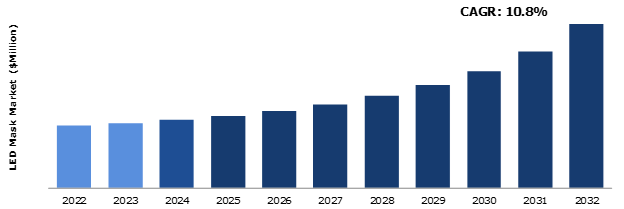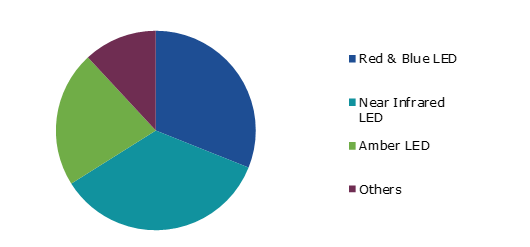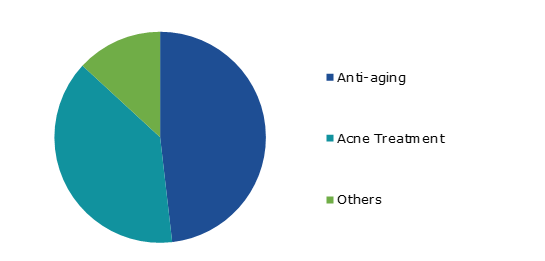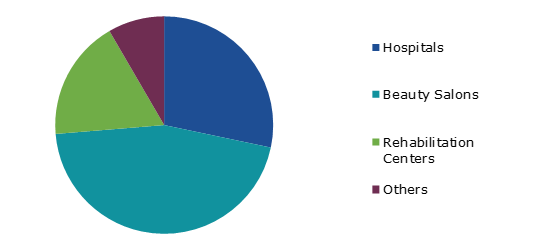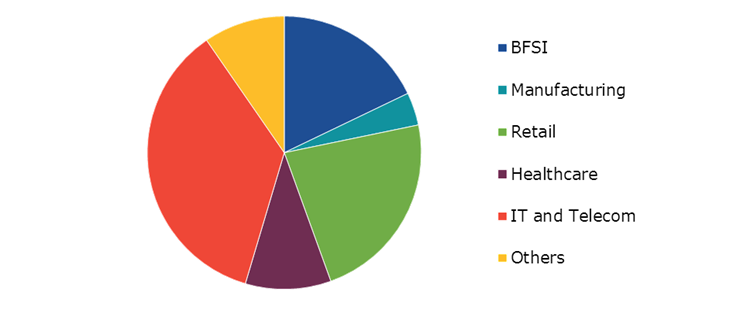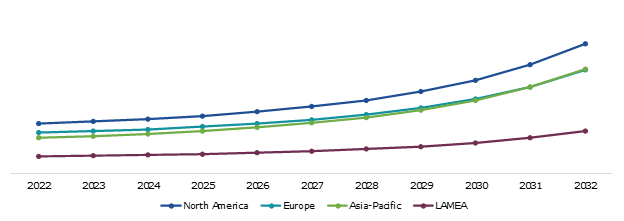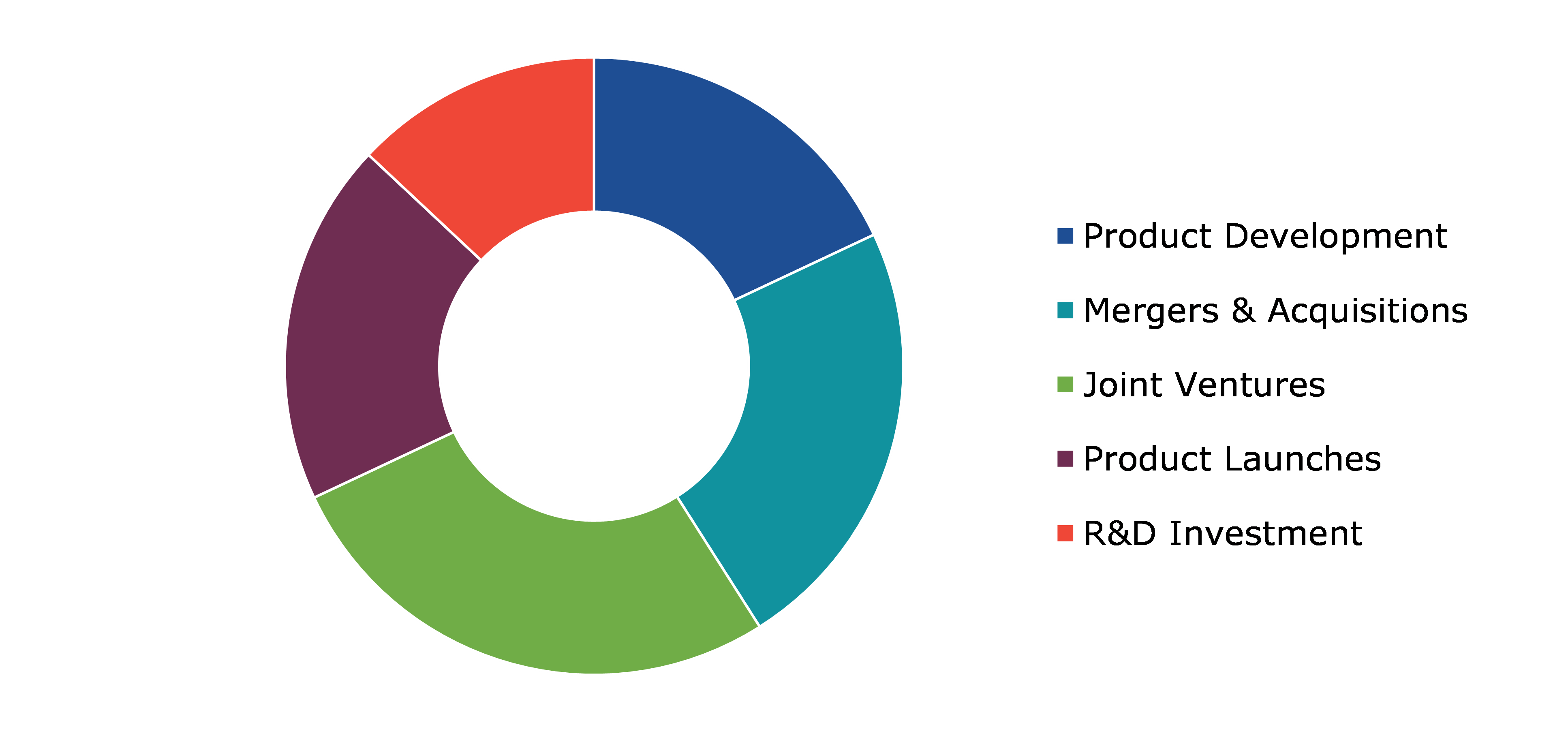LED Mask Market Report
RA08765
LED Mask Market by Type (Red & Blue LED, Near Infrared LED, Amber LED, and Others), Application (Anti-aging, Acne Treatment, and Others), End User (Hospitals, Beauty Salons, Rehabilitation Centers, and Others), Distribution Channel (Offline and Online), and Region (North America, Europe, Asia-Pacific, and LAMEA): Opportunity Analysis and Industry Forecast, 2023-2032
LED Mask Overview
A LED mask is a skincare device that utilizes light-emitting diodes (LEDs) to address various skin issues. Worn over the face, the mask emits specific wavelengths of LED light that penetrate the skin, delivering therapeutic benefits. There are three main types of LED light commonly used in these masks. The red light stimulates collagen production, reduces fine lines and wrinkles, and enhances skin elasticity, making it ideal for anti-aging purposes. Blue light targets and eliminates acne-causing bacteria, reducing inflammation and preventing further breakouts. Amber or yellow light calms and soothes the skin, helping to reduce redness and irritation. LED therapy is generally considered secure and non-invasive. However, following the manufacturer's instructions and avoiding direct exposure to LED lights is crucial. Consulting with a dermatologist or skincare professional is advisable to ensure suitability for individual skin types and concerns.
Global LED Mask Market Analysis
The global LED mask market size was $267.3 million in 2022 and is predicted to grow with a CAGR of 10.8%, by generating a revenue of $702.9 million by 2032.
Source: Research Dive Analysis
COVID-19 Impact on Global LED Mask Market
The COVID-19 pandemic had significant effects on the LED mask market. As the world faced lockdowns and restrictions, LED light face masks' supply chains and manufacturing encountered disruptions, leading to supply shortages and delayed product launches. The pandemic's economic uncertainties resulted in reduced consumer spending on non-essential items, including beauty products like LED light face masks. However, the emphasis on personal health and wellness during the pandemic prompted some individuals to invest in LED light face masks for at-home beauty treatments. The shift towards e-commerce and online shopping also led to LED mask manufacturers and retailers focusing more on digital sales channels. The pandemic's impact also led to increase in innovation and research efforts in the LED mask industry.
Increasing Awareness of Skincare to Drive the Market Growth
Increasing consumer awareness about skincare and beauty treatments has led to an increase in the demand for innovative and effective products. LED light face masks, a convenient and non-invasive choice for improving skin conditions such as acne, wrinkles, and pigmentation, have gained popularity among consumers in the recent years. Advancements in LED technology have made these masks more effective and accessible, with portable and wearable options allowing users to use them conveniently at home. Moreover, celebrity endorsements and social media influencers have played a crucial role in popularizing LED light face masks, influencing consumers' purchasing decisions. The rising trend of self-care and wellness, along with an increasing willingness to spend on skincare, has further boosted the LED mask market growth. In addition, the availability of customizable LED light face masks and positive clinical research findings have instilled confidence in consumers about the benefits of LED light therapy. The LED mask market has witnessed robust growth with improved distribution channels and the preference for at-home beauty treatments.
To know more about global LED mask market drivers, get in touch with our analysts here.
High Cost of LED to Restrain the Market Growth
The high cost of LED light face masks compared to traditional skincare products or treatments might limit their penetration, especially among price-sensitive consumers. In addition, limited awareness about LED light face masks' benefits could hamper its adoption rate. Competing with other advanced skincare treatments, such as laser therapies or chemical peels, is another challenge for LED light face masks. Uncertainty about their efficacy and safety concerns, particularly when purchasing from unregulated sources, may hinder market growth. As the market expands, it could face saturation, leading to intense competition and reduced profit margins. Regulatory restrictions and limited efficacy for all skin types could further impact market dynamics. Moreover, technological advancements in other skincare treatments may hamper the LED masks market demand in the upcoming years.
Advancements in LED Technology to Drive Excellent Opportunities
Technological advances in LED technology can further boost this market by enhancing the efficiency and effectiveness of LED light face masks through new wavelengths, intensity levels, and customizable settings. The trend of at-home beauty treatments and self-care products creates a favorable environment for LED light face masks targeted at consumers seeking DIY beauty solutions. In addition, positioning LED light face masks in the wellness and personal care devices segment is expected to create numerous growth opportunities. Collaborating with skincare brands or cosmetic companies can widen LED light face masks' market reach and visibility. Moreover, exploring medical and therapeutic applications in wound healing and skin conditions can unlock new opportunities in the healthcare sector. E-commerce platforms offer a global reach, facilitating international market penetration for LED mask manufacturers. Raising awareness about the benefits of LED light face masks and offering education on proper usage can further drive consumer interest.
Global LED Mask Market Share, by Type, 2022
Source: Research Dive Analysis
The near infrared LED sub-segment accounted for the highest LED mask market share in 2022. Near-infrared LED face masks offer several advantages and benefits when used as part of a skincare routine or light therapy treatment. Near-infrared light can penetrate deep into the skin, reaching the dermal layer and stimulating collagen formation. Collagen is an essential protein that promotes skin suppleness and decreases the appearance of fine lines and wrinkles. The usage of near-infrared LED face masks on a regular basis can result in smoother and more even skin texture. It may aid in the reduction of enlarged pores and the improvement of overall skin tone. Enhanced skin hydration treatments can enhance blood circulation, which can contribute to better skin hydration and a healthier complexion.
Global LED Mask Market Share, by Application, 2022
Source: Research Dive Analysis
The anti-aging sub-segment accounted for the highest market share in 2022. Anti-aging treatments have the potential to significantly boost the LED mask market growth. LED masks, particularly those that use near-infrared light, have grown in favor as a non-invasive and effective way to battle aging signs. LED masks' anti-aging advantages are one of the primary causes driving the increase in demand for these products. LED anti-aging masks, particularly those that emit near-infrared light, encourage collagen formation in the skin. Collagen is necessary for skin elasticity and firmness, and its deficiency is one of the leading causes of wrinkles and drooping skin. LED masks can help minimize the appearance of fine lines and wrinkles by stimulating collagen formation, making them a popular anti-aging treatment.
Global LED Mask Market Share, by End User, 2022
Source: Research Dive Analysis
The beauty salons sub-segment accounted for the highest LED mask market share in 2022. LED light therapy face masks are extremely popular in spas. They are utilized for a variety of reasons, including skin tightening, acne reduction, and wrinkle reduction. LED light therapy face masks operate by releasing specific wavelengths of light that penetrate deep into the skin and stimulate collagen and elastin formation. LED light therapy face masks are a non-invasive and painless method of achieving young and beautiful skin. One of the primary reasons driving the segment expansion during the forecast period is the growing presence of beauty salons in emerging markets around the world. The segment is predicted to develop due to an increase in the number of skin-conscious women and an increase in the prevalence of pollution in metropolitan areas during the forecast years. Growing awareness of LED masks among the population and professionals such as actors and models is expected to accelerate the segment growth in the future.
Global LED Mask Market Share, by Distribution Channel, 2022
Source: Research Dive Analysis
The offline sub-segment accounted for the highest market share in 2022. Traditional brick-and-mortar retail locations, such as beauty specialty shops, skincare boutiques, and department stores, allow customers to see and try LED masks before making a purchase. Considering the costs of LED face masks, consumers may prefer purchasing it offline. LED light therapy treatments are also available at many spas and beauty salons as part of their skincare services. In addition to these services, they frequently sell LED masks to consumers who want to continue their treatments at home. Recommendations from beauty professionals can be persuasive, boosting consumer interest in LED masks. These factors are expected to boost the LED mask market growth globally.
Global LED Mask Market Size & Forecast, by Region, 2022-2032 ($Million)
Source: Research Dive Analysis
The North America LED mask market analysis generated the highest revenue in 2022. The primary factors driving market expansion include rising consumer spending on beauty and personal care products, as well as the growing popularity of premium skincare brands among celebrities in the region. According to a SkinStore survey, Americans spend approximately $322 per year on skin care products. Consumers, particularly women, are adding skin-friendly skincare gadgets and products into their beauty routines to enhance skin conditions, which is expected to boost LED mask development. Furthermore, the presence of premium beauty and skincare companies like DMH Aesthetics, CELLRETURN, Skin Gym, and Aduro in the region is expected to boost market growth.
Competitive Scenario in the Global LED Mask Market
Investment and agreement are common strategies followed by major market players. In July 2022, OVE, a LED light face mask was introduced by Dior in collaboration with the French lighting manufacturer Lucibel. A wavelength of 635 nanometers is emitted by the LED light face mask in order to treat wrinkles and enter the skin more deeply. This LED light face mask will be sold at Dior Spas and Dior Beauty Corners, as well as in opulent retreats.
Source: Research Dive Analysis
Some of the leading LED mask market players are LG, CURRENTBODY, Skin Gym, MZ SKIN LIMITED, Aduro, Project E Beauty, DMH Aesthetics, Kahlia Skin, and Harpar Grace International (Déesse PRO).
| Aspect | Particulars |
| Historical Market Estimations | 2020-2021 |
| Base Year for Market Estimation | 2022 |
| Forecast Timeline for Market Projection | 2023-2032 |
| Geographical Scope | North America, Europe, Asia-Pacific, and LAMEA |
| Segmentation by Type |
|
| Segmentation by Application |
|
|
Segmentation by End User
|
|
|
Segmentation by Distribution Channel
|
|
| Key Companies Profiled |
|
Q1. What is the size of the global LED mask market?
A. The size of the global LED mask market was over $267.3 million in 2022 and is projected to reach $702.9 million by 2032.
Q2. Which are the major companies in the LED mask market?
A. LG Electronics and CURRENTBODY are some of the key players in the global LED mask market.
Q3. Which region, among others, possesses greater investment opportunities in the future?
A. Asia-Pacific possesses great investment opportunities for investors in the future.
Q4. What will be the growth rate of the Asia-Pacific LED mask market?
A. Asia-Pacific LED mask market is anticipated to grow at 12% CAGR during the forecast period.
Q5. What are the strategies opted by the leading players in this market?
A. Agreement and investment are the two key strategies opted by the operating companies in this market.
Q6. Which companies are investing more on R&D practices?
A. LG Electronics, CURRENTBODY, and Skin Gym. are the companies investing more on R&D activities for developing new products and technologies.
1.Research Methodology
1.1.Desk Research
1.2.Real time insights and validation
1.3.Forecast model
1.4.Assumptions and forecast parameters
1.5.Market size estimation
1.5.1.Top-down approach
1.5.2.Bottom-up approach
2.Report Scope
2.1.Market definition
2.2.Key objectives of the study
2.3.Report overview
2.4.Market segmentation
2.5.Overview of the impact of COVID-19 on Global LED Mask market
3.Executive Summary
4.Market Overview
4.1.Introduction
4.2.Growth impact forces
4.2.1.Drivers
4.2.2.Restraints
4.2.3.Opportunities
4.3.Market value chain analysis
4.3.1.List of raw material suppliers
4.3.2.List of manufacturers
4.3.3.List of distributors
4.4.Innovation & sustainability matrices
4.4.1.Technology matrix
4.4.2.Regulatory matrix
4.5.Porter’s five forces analysis
4.5.1.Bargaining power of suppliers
4.5.2.Bargaining power of consumers
4.5.3.Threat of substitutes
4.5.4.Threat of new entrants
4.5.5.Competitive rivalry intensity
4.6.PESTLE analysis
4.6.1.Political
4.6.2.Economical
4.6.3.Social
4.6.4.Technological
4.6.5.Environmental
4.7.Impact of COVID-19 on LED Mask market
4.7.1.Pre-covid market scenario
4.7.2.Post-covid market scenario
5.LED Mask Market Analysis, by Deployment Model
5.1.Overview
5.2.Red & Blue LED
5.2.1.Definition, key trends, growth factors, and opportunities
5.2.2.Market size analysis, by region, 2022-2032
5.2.3.Market share analysis, by country, 2022-2032
5.3.Near Infrared LED
5.3.1.Definition, key trends, growth factors, and opportunities
5.3.2.Market size analysis, by region, 2022-2032
5.3.3.Market share analysis, by country, 2022-2032
5.4.Amber LED
5.4.1.Definition, key trends, growth factors, and opportunities
5.4.2.Market size analysis, by region, 2022-2032
5.4.3.Market share analysis, by country, 2022-2032
5.5.Others
5.5.1.Definition, key trends, growth factors, and opportunities
5.5.2.Market size analysis, by region, 2022-2032
5.5.3.Market share analysis, by country, 2022-2032
5.6.Research Dive Exclusive Insights
5.6.1.Market attractiveness
5.6.2.Competition heatmap
6.LED Mask Market Analysis, by Application
6.1.Anti-aging
6.1.1.Definition, key trends, growth factors, and opportunities
6.1.2.Market size analysis, by region, 2022-2032
6.1.3.Market share analysis, by country, 2022-2032
6.2.Acne Treatment
6.2.1.Definition, key trends, growth factors, and opportunities
6.2.2.Market size analysis, by region, 2022-2032
6.2.3.Market share analysis, by country, 2022-2032
6.3.Others
6.3.1.Definition, key trends, growth factors, and opportunities
6.3.2.Market size analysis, by region, 2022-2032
6.3.3.Market share analysis, by country, 2022-2032
6.4.Research Dive Exclusive Insights
6.4.1.Market attractiveness
6.4.2.Competition heatmap
7.LED Mask Market Analysis, by End User
7.1.Hospitals
7.1.1.Definition, key trends, growth factors, and opportunities
7.1.2.Market size analysis, by region, 2022-2032
7.1.3.Market share analysis, by country, 2022-2032
7.2.Beauty Salons
7.2.1.Definition, key trends, growth factors, and opportunities
7.2.2.Market size analysis, by region, 2022-2032
7.2.3.Market share analysis, by country, 2022-2032
7.3.Rehabilitation Centers
7.3.1.Definition, key trends, growth factors, and opportunities
7.3.2.Market size analysis, by region, 2022-2032
7.3.3.Market share analysis, by country, 2022-2032
7.4.Others
7.4.1.Definition, key trends, growth factors, and opportunities
7.4.2.Market size analysis, by region, 2022-2032
7.4.3.Market share analysis, by country, 2022-2032
7.5.Research Dive Exclusive Insights
7.5.1.Market attractiveness
7.5.2.Competition heatmap
8.LED Mask Market Analysis, by Distribution Channel
8.1.Online
8.1.1.Definition, key trends, growth factors, and opportunities
8.1.2.Market size analysis, by region, 2022-2032
8.1.3.Market share analysis, by country, 2022-2032
8.2.Offline
8.2.1.Definition, key trends, growth factors, and opportunities
8.2.2.Market size analysis, by region, 2022-2032
8.2.3.Market share analysis, by country, 2022-2032
8.3.Research Dive Exclusive Insights
8.3.1.Market attractiveness
8.3.2.Competition heatmap
9.LED Mask Market, by Region
9.1.North America
9.1.1.U.S.
9.1.1.1.Market size analysis, by Type, 2022-2032
9.1.1.2.Market size analysis, by Application, 2022-2032
9.1.1.3.Market size analysis, by End User, 2022-2032
9.1.1.4.Market size analysis, by Distribution channel, 2022-2032
9.1.2.Canada
9.1.2.1.Market size analysis, by Type, 2022-2032
9.1.2.2.Market size analysis, by Application, 2022-2032
9.1.2.3.Market size analysis, by End User, 2022-2032
9.1.2.4.Market size analysis, by Distribution channel, 2022-2032
9.1.3.Mexico
9.1.3.1.Market size analysis, by Type, 2022-2032
9.1.3.2.Market size analysis, by Application, 2022-2032
9.1.3.3.Market size analysis, by End User, 2022-2032
9.1.3.4.Market size analysis, by Distribution channel, 2022-2032
9.1.4.Research Dive Exclusive Insights
9.1.4.1.Market attractiveness
9.1.4.2.Competition heatmap
9.2.Europe
9.2.1.Germany
9.2.1.1.Market size analysis, by Type, 2022-2032
9.2.1.2.Market size analysis, by Application, 2022-2032
9.2.1.3.Market size analysis, by End User, 2022-2032
9.2.1.4.Market size analysis, by Distribution channel, 2022-2032
9.2.2.UK
9.2.2.1.Market size analysis, by Type, 2022-2032
9.2.2.2.Market size analysis, by Application, 2022-2032
9.2.2.3.Market size analysis, by End User, 2022-2032
9.2.2.4.Market size analysis, by Distribution channel, 2022-2032
9.2.3.France
9.2.3.1.Market size analysis, by Type, 2022-2032
9.2.3.2.Market size analysis, by Application, 2022-2032
9.2.3.3.Market size analysis, by End User, 2022-2032
9.2.3.4.Market size analysis, by Distribution channel, 2022-2032
9.2.4.Spain
9.2.4.1.Market size analysis, by Type, 2022-2032
9.2.4.2.Market size analysis, by Application, 2022-2032
9.2.4.3.Market size analysis, by End User, 2022-2032
9.2.4.4.Market size analysis, by Distribution channel, 2022-2032
9.2.5.Italy
9.2.5.1.Market size analysis, by Type, 2022-2032
9.2.5.2.Market size analysis, by Application, 2022-2032
9.2.5.3.Market size analysis, by End User, 2022-2032
9.2.5.4.Market size analysis, by Distribution channel, 2022-2032
9.2.6.Rest of Europe
9.2.6.1.Market size analysis, by Type, 2022-2032
9.2.6.2.Market size analysis, by Application, 2022-2032
9.2.6.3.Market size analysis, by End User, 2022-2032
9.2.6.4.Market size analysis, by Distribution channel, 2022-2032
9.2.7.Research Dive Exclusive Insights
9.2.7.1.Market attractiveness
9.2.7.2.Competition heatmap
9.3.Asia-Pacific
9.3.1.China
9.3.1.1.Market size analysis, by Type, 2022-2032
9.3.1.2.Market size analysis, by Application, 2022-2032
9.3.1.3.Market size analysis, by End User, 2022-2032
9.3.1.4.Market size analysis, by Distribution channel, 2022-2032
9.3.2.Japan
9.3.2.1.Market size analysis, by Type, 2022-2032
9.3.2.2.Market size analysis, by Application, 2022-2032
9.3.2.3.Market size analysis, by End User, 2022-2032
9.3.2.4.Market size analysis, by Distribution channel, 2022-2032
9.3.3.India
9.3.3.1.Market size analysis, by Type, 2022-2032
9.3.3.2.Market size analysis, by Application, 2022-2032
9.3.3.3.Market size analysis, by End User, 2022-2032
9.3.3.4.Market size analysis, by Distribution channel, 2022-2032
9.3.4.Australia
9.3.4.1.Market size analysis, by Type, 2022-2032
9.3.4.2.Market size analysis, by Application, 2022-2032
9.3.4.3.Market size analysis, by End User, 2022-2032
9.3.4.4.Market size analysis, by Distribution channel, 2022-2032
9.3.5.South Korea
9.3.5.1.Market size analysis, by Type, 2022-2032
9.3.5.2.Market size analysis, by Application, 2022-2032
9.3.5.3.Market size analysis, by End User, 2022-2032
9.3.5.4.Market size analysis, by Distribution channel, 2022-2032
9.3.6.Rest of Asia-Pacific
9.3.6.1.Market size analysis, by Type, 2022-2032
9.3.6.2.Market size analysis, by Application, 2022-2032
9.3.6.3.Market size analysis, by End User, 2022-2032
9.3.6.4.Market size analysis, by Distribution channel, 2022-2032
9.3.7.Research Dive Exclusive Insights
9.3.7.1.Market attractiveness
9.3.7.2.Competition heatmap
9.4.LAMEA
9.4.1.Brazil
9.4.1.1.Market size analysis, by Type, 2022-2032
9.4.1.2.Market size analysis, by Application, 2022-2032
9.4.1.3.Market size analysis, by End User, 2022-2032
9.4.1.4.Market size analysis, by Distribution channel, 2022-2032
9.4.2.Saudi Arabia
9.4.2.1.Market size analysis, by Type, 2022-2032
9.4.2.2.Market size analysis, by Application, 2022-2032
9.4.2.3.Market size analysis, by End User, 2022-2032
9.4.2.4.Market size analysis, by Distribution channel, 2022-2032
9.4.3.UAE
9.4.3.1.Market size analysis, by Type, 2022-2032
9.4.3.2.Market size analysis, by Application, 2022-2032
9.4.3.3.Market size analysis, by End User, 2022-2032
9.4.3.4.Market size analysis, by Distribution channel, 2022-2032
9.4.4.South Africa
9.4.4.1.Market size analysis, by Type, 2022-2032
9.4.4.2.Market size analysis, by Application, 2022-2032
9.4.4.3.Market size analysis, by End User, 2022-2032
9.4.4.4.Market size analysis, by Distribution channel, 2022-2032
9.4.5.Rest of LAMEA
9.4.5.1.Market size analysis, by Type, 2022-2032
9.4.5.2.Market size analysis, by Application, 2022-2032
9.4.5.3.Market size analysis, by End User, 2022-2032
9.4.5.4.Market size analysis, by Distribution channel, 2022-2032
9.4.6.Research Dive Exclusive Insights
9.4.6.1.Market attractiveness
9.4.6.2.Competition heatmap
10.Competitive Landscape
10.1.Top winning strategies, 2022
10.1.1.By strategy
10.1.2.By year
10.2.Strategic overview
10.3.Market share analysis, 2022
11.Company Profiles
11.1.LG
11.1.1.Overview
11.1.2.Business segments
11.1.3.Product portfolio
11.1.4.Financial performance
11.1.5.Recent developments
11.1.6.SWOT analysis
11.2.CURRENTBODY
11.2.1.Overview
11.2.2.Business segments
11.2.3.Product portfolio
11.2.4.Financial performance
11.2.5.Recent developments
11.2.6.SWOT analysis
11.3.Skin Gym
11.3.1.Overview
11.3.2.Business segments
11.3.3.Product portfolio
11.3.4.Financial performance
11.3.5.Recent developments
11.3.6.SWOT analysis
11.4.MZ SKIN LIMITED
11.4.1.Overview
11.4.2.Business segments
11.4.3.Product portfolio
11.4.4.Financial performance
11.4.5.Recent developments
11.4.6.SWOT analysis
11.5.Aduro
11.5.1.Overview
11.5.2.Business segments
11.5.3.Product portfolio
11.5.4.Financial performance
11.5.5.Recent developments
11.5.6.SWOT analysis
11.6.Project E Beauty
11.6.1.Overview
11.6.2.Business segments
11.6.3.Product portfolio
11.6.4.Financial performance
11.6.5.Recent developments
11.6.6.SWOT analysis
11.7.DMH Aesthetics
11.7.1.Overview
11.7.2.Business segments
11.7.3.Product portfolio
11.7.4.Financial performance
11.7.5.Recent developments
11.7.6.SWOT analysis
11.8.Kahlia Skin
11.8.1.Overview
11.8.2.Business segments
11.8.3.Product portfolio
11.8.4.Financial performance
11.8.5.Recent developments
11.8.6.SWOT analysis
11.9.Harpar Grace International (Déesse PRO)
11.9.1.Overview
11.9.2.Business segments
11.9.3.Product portfolio
11.9.4.Financial performance
11.9.5.Recent developments
11.9.6.SWOT analysis
11.10.CELLRETURN
11.10.1.Overview
11.10.2.Business segments
11.10.3.Product portfolio
11.10.4.Financial performance
11.10.5.Recent developments
11.10.6.SWOT analysis
Personalize this research
- Triangulate with your own data
- Request your format and definition
- Get a deeper dive on a specific application, geography, customer or competitor
- + 1-888-961-4454 Toll - Free
- support@researchdive.com

